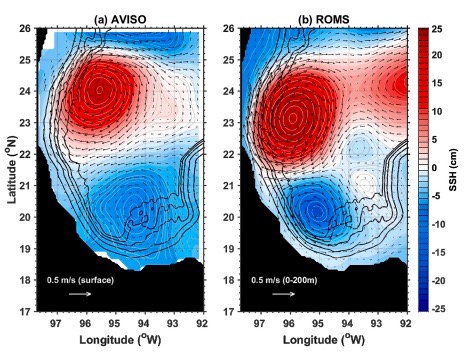Authors: Lorena Guerrero, Julio Sheinbaum, Ismael Mariño-Tapia, Joana Julieta Gonzalez-Rejón, Paula Pérez-Brunius
https://doi.org/10.1016/j.csr.2020.104243
Abstract:
This study uses ROMS (Regional Ocean Modeling System) with realistic forcing to analyse cross-shelf transport
associated with the presence of mesoscale anticyclones as they interact with the western shelf of the Gulf of
Mexico. Daily outputs from this validated 15-year numerical simulation were used to calculate the depth and
time averaged cross-shelf volume transport through the 200 m isobath, used as a proxy for the shelf break.
Composites for cases in which mesoscale anticyclones (MAs) are close or far away from the shelf break were
performed to show that cross-shelf exchange has remarkable differences when they interact with the shelf. These
differences consist of: a) enhanced off-shelf transport on its northern rim (at ~ 25.5oN), b) a flow with multiple
inversions associated with the main body of the MA where both on and off-shelf transports are considerably
increased, and c) enhanced on-shelf transport at its southern edge, linked to the interaction of the MA with the
persistent mesoscale cyclonic circulation in the Bay of Campeche. The multiple transport inversions associated
with the main body of the MA is clearly linked with spatial patterns of baroclinic and barotropic instabilities that
develop at the rings edge. The time-evolution of a representative event in which an MA interacts with the shelf is
analysed to verify the influence on cross-shelf transport observed in the composites. Results show that enhanced
cross-shelf transport is driven by the proximity, shape, and angle of orientation of the anticyclone with respect to
the shelf. The Eulerian analysis of the event coincides with the composite results described above with enhanced
cross-shelf exchange when the MA is rounder and closer to the shelf. A Lagrangian experiment is carried out to
quantify the exchange and fate of particles during this “typical eddy event”, seeding drifters within the shelf,
inside the MA and in the open waters outside the eddy. Results show a substantial increase in exchange rate and
distance traveled by particles (they travel 200 km farther) when the MA is closer to the shelf.
Keywords: Mesoscale eddies; Enhanced off-shelf transport; Eddy-shelf interaction


Recent Comments